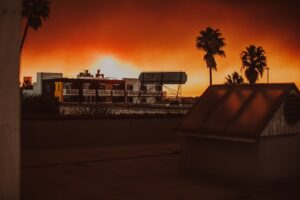Physical Address
23,24,25 & 26, 2nd Floor, Software Technology Park India, Opp: Garware Stadium,MIDC, Chikalthana, Aurangabad, Maharashtra – 431001 India
Physical Address
23,24,25 & 26, 2nd Floor, Software Technology Park India, Opp: Garware Stadium,MIDC, Chikalthana, Aurangabad, Maharashtra – 431001 India

California’s climate crisis puts the spotlight on a troubling trend: the rapid alternation between extreme wet and dry conditions, known as “hydroclimate whiplash.” A recent study published in Nature Reviews highlights how this phenomenon intensifies worldwide due to global warming.
After years of severe drought, California faced record-breaking precipitation during winter 2022-23, fueled by dozens of atmospheric rivers. These events led to snow-choked mountain towns, flooded valleys, and widespread landslides.
In 2024, a second wet winter encouraged abundant vegetation growth in southern California. However, a record-hot summer and an unusually dry start to the 2025 rainy season left the landscape parched. This sequence created ideal conditions for devastating wildfires, driven by tinder-dry vegetation.
According to lead author Daniel Swain, a climate scientist at UCLA, hydroclimate whiplash doubles fire risk by first promoting vegetation growth during wet periods, then drying it out under extreme heat and aridity.
The study identifies global warming as the primary driver of hydroclimate whiplash, emphasizing the role of an “expanding atmospheric sponge.” As the planet warms, the atmosphere’s capacity to absorb and release moisture increases by 7% per degree Celsius. Swain explains, “The problem is that the sponge grows exponentially, like compound interest in a bank. The rate of expansion increases with each fraction of a degree of warming.”
The impact is alarming. Hydroclimate whiplash has already increased globally by 31% to 66% since the mid-20th century. If global temperatures rise by 3°C above pre-industrial levels, this phenomenon could more than double, with devastating consequences for water management, agriculture, and disaster resilience.
California epitomizes the challenges of managing these extremes. Recent years have showcased rapid transitions from severe drought to record-breaking rainfall and back again, straining water infrastructure and highlighting vulnerabilities. Co-author John Abatzoglou from UC Merced notes that traditional water management strategies—such as directing floodwaters to the ocean or slow groundwater recharge—may be insufficient in addressing both extremes simultaneously. This variability demands innovative, integrated approaches to water management that account for both drought and flood risks.
The study warns that hydroclimate whiplash will intensify most in regions like northern Africa, the Middle East, South Asia, and the tropical Pacific, but its effects will be felt worldwide.
In Southern California, where wildfires rage, the connection between climate change and fire risk is clear. While there’s no direct evidence linking global warming to the region’s wind events, Swain notes that climate change aggravates fire risk by extending the overlap between extremely dry vegetation and these wind events.
The findings highlight the urgency of mitigating global warming to limit hydroclimate whiplash.
References:
https://www.nature.com/articles/s43017-024-00624-z
https://newsroom.ucla.edu/releases/floods-droughts-fires-hydroclimate-whiplash-speeding-up-globally
Banner Image : Photo by Jessica Christian on Unsplash
Comments are closed.
Os brasileiros pessoas desfrutam de um problema!
As final impressões do sítio Web jogo indústria são as do jogos de azar actividades.
Estes jogos apresentam plano, bom acaso,
bónus, e um monte de sentimento. Eles foram projetados por designers.
À medida que o desporto progride, os atletas são obrigados a apostar no compostos
pré-jogo normas à medida que o múltiplo reforça. Quando as coisas estão a correr bem, porque um incidente está prestes a
ocorrer, o objetivo é ganho. https://groups.google.com/g/sheasjkdcdjksaksda/c/l9DXw5d1uWU